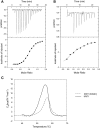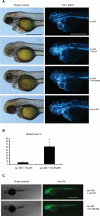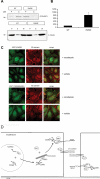A mechanism of Rap1-induced stabilization of endothelial cell--cell junctions
- PMID: 21633110
- PMCID: PMC3135476
- DOI: 10.1091/mbc.E11-02-0157
A mechanism of Rap1-induced stabilization of endothelial cell--cell junctions
Abstract
Activation of Rap1 small GTPases stabilizes cell--cell junctions, and this activity requires Krev Interaction Trapped gene 1 (KRIT1). Loss of KRIT1 disrupts cardiovascular development and causes autosomal dominant familial cerebral cavernous malformations. Here we report that native KRIT1 protein binds the effector loop of Rap1A but not H-Ras in a GTP-dependent manner, establishing that it is an authentic Rap1-specific effector. By modeling the KRIT1-Rap1 interface we designed a well-folded KRIT1 mutant that exhibited a ~40-fold-reduced affinity for Rap1A and maintained other KRIT1-binding functions. Direct binding of KRIT1 to Rap1 stabilized endothelial cell-cell junctions in vitro and was required for cardiovascular development in vivo. Mechanistically, Rap1 binding released KRIT1 from microtubules, enabling it to locate to cell--cell junctions, where it suppressed Rho kinase signaling and stabilized the junctions. These studies establish that the direct physical interaction of Rap1 with KRIT1 enables the translocation of microtubule-sequestered KRIT1 to junctions, thereby supporting junctional integrity and cardiovascular development.
Figures








Similar articles
-
Structural basis of the junctional anchorage of the cerebral cavernous malformations complex.J Cell Biol. 2012 Oct 1;199(1):39-48. doi: 10.1083/jcb.201205109. Epub 2012 Sep 24. J Cell Biol. 2012. PMID: 23007647 Free PMC article.
-
The structure of the ternary complex of Krev interaction trapped 1 (KRIT1) bound to both the Rap1 GTPase and the heart of glass (HEG1) cytoplasmic tail.J Biol Chem. 2013 Aug 16;288(33):23639-49. doi: 10.1074/jbc.M113.462911. Epub 2013 Jun 27. J Biol Chem. 2013. PMID: 23814056 Free PMC article.
-
KRIT-1/CCM1 is a Rap1 effector that regulates endothelial cell cell junctions.J Cell Biol. 2007 Oct 22;179(2):247-54. doi: 10.1083/jcb.200705175. J Cell Biol. 2007. PMID: 17954608 Free PMC article.
-
KRIT1: A Traffic Warden at the Busy Crossroads Between Redox Signaling and the Pathogenesis of Cerebral Cavernous Malformation Disease.Antioxid Redox Signal. 2023 Mar;38(7-9):496-528. doi: 10.1089/ars.2021.0263. Epub 2022 Nov 1. Antioxid Redox Signal. 2023. PMID: 36047808 Free PMC article. Review.
-
Recent insights into cerebral cavernous malformations: a complex jigsaw puzzle under construction.FEBS J. 2010 Mar;277(5):1084-96. doi: 10.1111/j.1742-4658.2009.07537.x. Epub 2010 Jan 22. FEBS J. 2010. PMID: 20096036 Free PMC article. Review.
Cited by
-
KRIT1-mediated regulation of neutrophil adhesion and motility.FEBS J. 2023 Feb;290(4):1078-1095. doi: 10.1111/febs.16627. Epub 2022 Sep 20. FEBS J. 2023. PMID: 36107440 Free PMC article.
-
Structure and vascular function of MEKK3-cerebral cavernous malformations 2 complex.Nat Commun. 2015 Aug 3;6:7937. doi: 10.1038/ncomms8937. Nat Commun. 2015. PMID: 26235885 Free PMC article.
-
Phospholipase Cε Modulates Rap1 Activity and the Endothelial Barrier.PLoS One. 2016 Sep 9;11(9):e0162338. doi: 10.1371/journal.pone.0162338. eCollection 2016. PLoS One. 2016. PMID: 27612188 Free PMC article.
-
Oxidative stress and inflammation in cerebral cavernous malformation disease pathogenesis: Two sides of the same coin.Int J Biochem Cell Biol. 2016 Dec;81(Pt B):254-270. doi: 10.1016/j.biocel.2016.09.011. Epub 2016 Sep 14. Int J Biochem Cell Biol. 2016. PMID: 27639680 Free PMC article. Review.
-
Signalling through cerebral cavernous malformation protein networks.Open Biol. 2020 Nov;10(11):200263. doi: 10.1098/rsob.200263. Epub 2020 Nov 25. Open Biol. 2020. PMID: 33234067 Free PMC article. Review.
References
-
- Bos JL. Linking Rap to cell adhesion. Curr Opin Cell Biol. 2005;17:123–128. - PubMed
-
- Cullere X, Shaw SK, Andersson L, Hirahashi J, Luscinskas FW, Mayadas TN. Regulation of vascular endothelial barrier function by Epac, a cAMP-activated exchange factor for Rap GTPase. Blood. 2005;105:1950–1955. - PubMed
Publication types
MeSH terms
Substances
LinkOut - more resources
Full Text Sources
Other Literature Sources
Molecular Biology Databases
Research Materials
Miscellaneous

